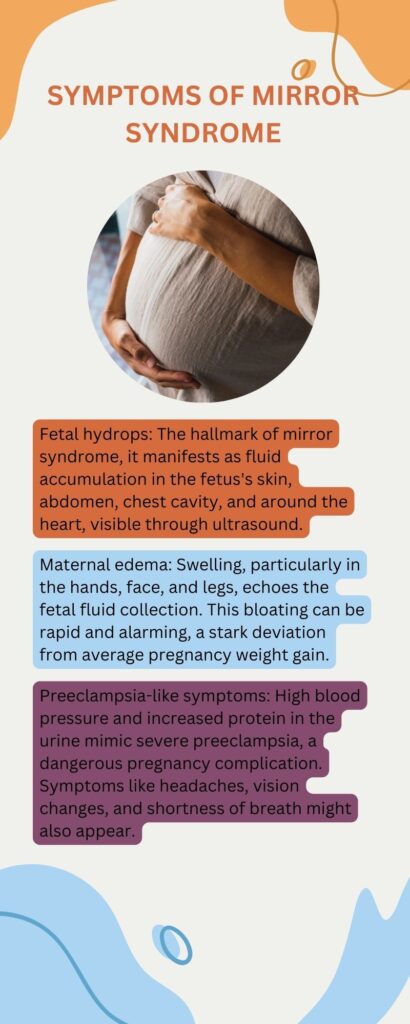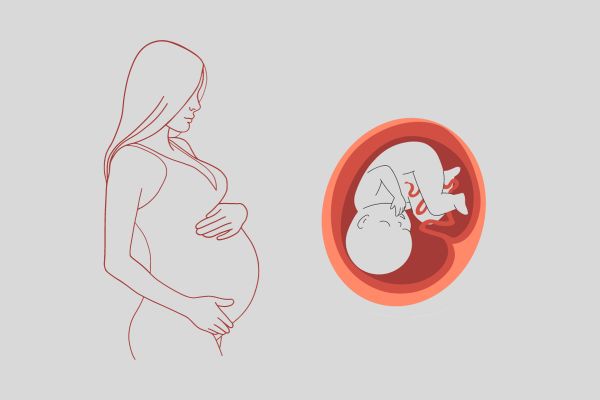Pregnancy, a period marked with immense joy and anticipation, can also entail unforeseen health risks. Mirror syndrome is a rare and potentially life-threatening condition that casts a dark reflection on this journey, manifesting the fetus’s distress in the mother’s own body. Cracking the mysteries of this syndrome, including its symptoms, diagnosis, and treatment options, is critical for providing the well-being of both the mother and the fetus. By doing so, healthcare providers can effectively safeguard against the potential dangers of this condition and promote a successful pregnancy outcome.
What is Mirror Syndrome?
Mirror syndrome, also known as Ballantyne syndrome or triple edema, is a rare obstetric disorder that presents a three-fold pathology comprising fetal hydrops, maternal edema, and preeclampsia-like symptoms. Essentially, the fetus sustains an abnormal accumulation of fluid within its body, which manifests as maternal edema and high blood pressure. The mother’s body reflects the fetal distress, resulting in a poignant and dangerous complication of pregnancy.
What are the symptoms of mirror syndrome?

While the severity varies, several symptoms serve as warning signs of the storm brewing within:
- Fetal hydrops: The hallmark of mirror syndrome, it manifests as fluid accumulation in the fetus’s skin, abdomen, chest cavity, and around the heart, visible through ultrasound.
- Maternal edema: Swelling, particularly in the hands, face, and legs, echoes the fetal fluid collection. This bloating can be rapid and alarming, a stark deviation from average pregnancy weight gain.
- Preeclampsia-like symptoms: High blood pressure and increased protein in the urine mimic severe preeclampsia, a dangerous pregnancy complication. Symptoms like headaches, vision changes, and shortness of breath might also appear.
What causes mirror syndrome?
The exact cause of mirror syndrome remains shrouded in mystery, but several factors are suspected to play a role:
- Fetal malformations: Congenital heart defects, chromosomal abnormalities, and other fetal conditions can disrupt fluid homeostasis, leading to hydrops.
- Placental issues: Abnormal placentation, infections, or tumors can affect fluid exchange between mother and fetus, contributing to both fetal and maternal fluid build-up.
- Twin-to-twin transfusion syndrome: In this scenario, one twin receives more blood than the other, leading to hydrops in the recipient and possible mirror syndrome in the mother.
- Maternal conditions: Autoimmune diseases, chronic hypertension, and severe infections can also trigger the syndrome.
How is mirror syndrome diagnosed?

Early diagnosis is crucial for optimal outcomes. Prenatal screening and regular checkups play a vital role. The main elements in the diagnostic puzzle include:
- Fetal ultrasound: Visualizing the fluid accumulation confirms fetal hydrops, the cardinal sign.
- Maternal blood and urine tests: High blood pressure, proteinuria, and blood count abnormalities point towards mirror syndrome or preeclampsia.
- Amniocentesis: In some cases, analyzing amniotic fluid can help identify underlying genetic or infectious causes.
How is mirror syndrome treated?
The course of treatment depends on the severity and underlying cause of mirror syndrome. The primary focus is to stabilize both mother and fetus:
- Fetal therapy: The primary focus of treatment is to stabilize both the mother and the fetus. Different interventions might be considered to achieve this, depending on the cause of the syndrome. Fetal therapy might be an option in some instances, where interventions like draining fetal fluid or placental surgery might be required to manage the condition.
- Maternal supportive care: Maternal supportive care is also a crucial aspect of treatment. It might involve medications to manage blood pressure, fluid restrictions, and bed rest. It is necessary to ensure that the mother is comfortable and that her health is not further compromised.
- Delivery: In severe cases, an early delivery might be necessary to safeguard both the mother and the fetus. However, this will depend on the severity of the syndrome, and the decision to proceed with delivery will be taken after careful consideration of the risks and benefits to both individuals involved.
Prognosis and Prevention
Mirror syndrome is an infrequent yet severe complication that can arise during pregnancy. It is characterized by the mother’s symptoms mimicking those of her unborn baby. This syndrome poses a considerable threat to both the mother and the fetus. However, with timely diagnosis and intervention, the likelihood of a favorable outcome is increased.
Nevertheless, the long-term ramifications of mirror syndrome for both the mother and child remain uncertain. Therefore, it is imperative to undertake necessary precautions and prioritize prenatal care to prevent the onset of this syndrome. Regular prenatal checkups hold immense significance in averting mirror syndrome. These checkups aid in identifying and managing pre-existing maternal conditions and closely monitoring fetal health.
In addition, fostering open communication and awareness of pregnancy complications are crucial factors in empowering pregnant women to seek immediate medical attention if symptoms arise. If you are pregnant, it is essential to maintain open communication with your healthcare provider and understand the risks associated with your pregnancy. By doing so, you can take the necessary measures to ensure a healthy pregnancy and a positive outcome.
Disclaimer
The information provided in this content is for general informational purposes only and should not be construed as medical advice. It is not a substitute for professional medical advice, diagnosis, or treatment. Always seek the advice of your physician or other qualified healthcare provider with any questions you may have regarding your specific medical situation. Never disregard professional medical advice or delay seeking it because of something you have read on this website. While the information contained herein is presented in good faith and believed to be accurate, no representation or warranty is made, express or implied, regarding the information’s completeness, accuracy, reliability, or suitability for any particular purpose. You assume all risk for the use of the information provided.





